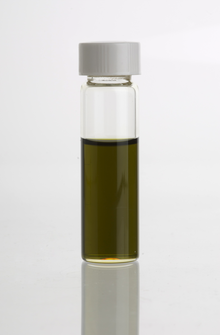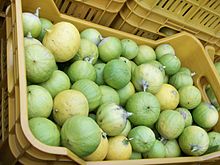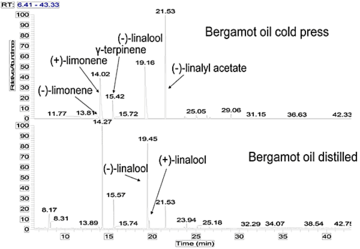Bergamot essential oil

Bergamot essential oil is a cold-pressed essential oil produced by cells inside the rind of a bergamot orange fruit. It is a common flavoring and top note in perfumes. The scent of bergamot essential oil is similar to a sweet light orange peel oil with a floral note.[1]
Production


The sfumatura or slow-folding process was the traditional technique for manually extracting the bergamot oil.[2] By more modern methods, the oil is extracted mechanically with machines called peelers, which scrape the outside of the fruit under running water to get an emulsion channeled into centrifuges for separating the essence from the water. The rinds of 100 bergamot oranges yield about 3 ounces (85 g) of bergamot oil.[3]
Uses

Bergamot essential oil has been used in cosmetics, aromatherapy, and as a flavoring in food and beverages.[4] Its citrus scent makes it a natural flavoring and deodorizing agent.[4] The volatile oils of the bergamot orange are described as flavoring agents in the USP Food Chemicals Codex and are generally recognized as safe for human consumption by the Food and Drug Administration.[5] For example, Earl Grey tea is a type of black tea that may contain bergamot essential oil as a flavoring agent.[4]
Historically, bergamot essential oil was an ingredient in Eau de Cologne, a perfume originally concocted by Johann Maria Farina at the beginning of the 18th century.[6] The first record of bergamot oil used as a fragrance in perfume is from 1714, found in the Farina Archive in Cologne.[7]
Constituents
A clear liquid (sometimes there is a deposit consisting of waxes) in color from green to greenish yellow, bergamot essential oil consists of a volatile fraction (average 95%) and a non-volatile fraction (5% or residual). Chemically, it is a complex mixture of many classes of organic substances, particularly in the volatile fraction, including
Volatile fraction
The main compounds in the oil are
Non-volatile fraction
The main non-volatile compounds are coumarins (citropten, 5-geranyloxy-7-methoxycoumarin) and furanocoumarins (bergapten, bergamottin).[9][10]
Adulteration

The bergamot essential oil is particularly subject to
Natural source analysis based on the Carbon-14 method can identify adulterated essences by detecting synthetic chemicals manufactured from petroleum that are used to mimic the chemical profile of bergamot oil and other essential oils.[citation needed]
Gas chromatography with columns having a chiral stationary phase allows analyzing mixtures of enantiomers. The analysis of the enantiomeric distribution of various compounds, such as linalyl acetate and linalool, allows the characterization of the bergamot oil according to the manufacturing process and allows for the detection of possible adulteration.[12][13][14][15]
The combined use of
The GC-C-IRMS (Gas Chromatography-Combustion – Isotope Ratio Mass Spectrometer) technique, the most recently used, allows obtaining similar results.[17]
Reference analytical values
Analytical values take as reference for genuinity evaluation of bergamot essential oil by the Experimental Station for the Industry of the Essential oils and Citrus products, in Reggio Calabria, Italy.[18]
| Chemical physical characteristics | Min | Max | Unit
|
|---|---|---|---|
| Refractive index at 20 °C (68 °F) | 1.4640 | 1.4690 | adim |
| Optical rotation at 20 °C (68 °F) | +15.0 | +34.0 | ° |
| Relative density at 20 °C (68 °F) | 0.875 | 0.883 | adim |
Esters (expressed as linalyl acetate )
|
30 | 45 | % |
| Evaporation residue | 4.50 | 6.50 | % |
| CD (spectrophotometric analysis) | 0.75 | 1.20 | adim |
| Main volatile fraction components | Min | Max | Unit |
|---|---|---|---|
| Limonene | 30 | 45 | % |
| Linalool | 3 | 15 | % |
| Linalyl acetate | 22 | 36 | % |
| γ-terpinene | 6 | 10 | % |
β-pinene
|
4.5 | 9 | % |
| Δ3- carene
|
trace | 0.008 | % |
| Terpinen-4-ol | trace | 0.06 | % |
| Enantiomeric ratios of main chiral components | Min | Max | Unit |
|---|---|---|---|
| Limonene ((+)-Limonene / (-)-Limonene) | (97.4 / 2.6) | (98.4 / 1.6) | % |
| Linalool ((+)-Linalool / (-)-Linalool) | (0.3 / 99.7) | (0.7 / 99.3) | % |
| Linalyl acetate ((+)-Linalyl acetate / (-)-Linalyl acetate) | (0.3 / 99.7) | (0.6 / 99.4) | % |
| Non-volatile residue components | Min | Max | Unit |
|---|---|---|---|
| Bergapten | 1800 | 3800 | mg/Kg |
Toxicity
The
Use of bergamot

Bergamot essential oil contains a significant amount of bergapten, a phototoxic substance that gets its name from the bergamot orange. Bergapten, a linear furanocoumarin derived from psoralen, is often found in plants associated with phytophotodermatitis.[21] Note that bergamot essential oil has a higher concentration of bergapten (3000–3600 mg/kg) than any other Citrus-based essential oil.[25]
When bergamot essential oil is applied directly to the skin via a
The International Fragrance Association (IFRA) restricts the use of bergamot essential oil due to its phototoxic effects. Specifically, IFRA recommends that leave-on skin products be limited to 0.4% bergamot oil,[4] which is more restrictive than any other Citrus-based essential oil.[5]
Although generally recognized as safe for human consumption, bergamot essential oil contains a significant amount of bergamottin, one of two furanocoumarins believed to be responsible for a number of grapefruit–drug interactions.[29][30] There are no direct reports of Earl Grey tea causing drug interactions.
In one case study, a patient who consumed four liters of Earl Grey tea per day suffered paresthesias, fasciculations and muscle cramps. The patient did not show these reactions when drinking the same amount of plain black tea daily; drinking no tea at all; or drinking only one liter of Earl Grey tea daily. The presumed culprit is bergapten, a potassium channel blocker found in bergamot oil.[31]
Notes
- ^ "Bergamot perfume ingredient, Bergamot fragrance and essential oils Citrus bergamia". Fragrantica.com. Retrieved 19 July 2018.
- ^ Angelo Di Giacomo e Biagio Mincione (1994). Gli Olii Essenziali Agrumari in Italia (in Italian). Reggio Calabria: Laruffa Editore.
- ^ Brannt, W.T; Schaedler, K. (1896). A Practical Treatise on Animal and Vegetable Fats and Oils, 2nd Edition (digitized 24 Sep 2007), page 449. The University of Michigan.
- ^ a b c d "Bergamot oil". Drugs.com. 2018. Retrieved 30 November 2018.
- ^ a b "Safety assessment of citrus-derived ingredients as used in cosmetics" (PDF). Cosmetic Ingredient Review. 3 December 2013. Retrieved 28 November 2018.
- ^ "Eau de Cologne. The world's oldest and most reproduced scent". Lampoon Magazine. 2021-05-08. Retrieved 2022-05-04.
- ^ "Bergamot in perfumery". www.sylvaine-delacourte.com. Retrieved 2022-05-04.
- ^ ISSN 0882-5734.
- S2CID 95863019.
- ^ PMID 19722564.
- ^ Tonio Licordari La riflessione Valorizzare ora questa risorsa sulla scia dell'onda... profumata Gazzetta del Sud Cronaca di Reggio. Retrieved on 18 February 2010.
- ISSN 0021-8561.
- PMID 19255543.
- ^ Burfield, T. "The adulteration of essential oils – and the consequences to aromatherapy & natural perfumery practice". Presented to the International Federation of Aromatherapists Annual AGM London Oct 11th 2003. Retrieved 16 June 2013.
- ISSN 0882-5734.
- ISSN 0021-8561.
- S2CID 97833423.
- ^ (in Italian and English) Francesco Gionfriddo e Domenico Castaldo (2004). "Ridefinizione dei parametri analico-composizionali dell'olio essenziale di bergamotto estratto a freddo / Ridefinition of analytical compositional parameters for "cold pressed" bergamot essential oil". Essenze Derivati Agrumari (74): 151–152.
- ^ Alikhan, A. (4 March 2016). "Berloque Dermatitis". Medscape. Retrieved 29 November 2018.
- . Cited in Alikhan 2016.
- ^ a b McGovern, T.W.; Barkley, T.M. (2000). "Botanical Dermatology". The Electronic Textbook of Dermatology. Internet Dermatology Society. Section Phytophotodermatitis. Retrieved November 29, 2018.
- ^ Freund, E. (1916). "Uber bisher noch nicht beschriebene kunstliche Hautverfarbungen". Dermatol Wochenschrift. 63: 931–933. Cited in McGovern and Barkley 2000, section Phytophotodermatitis.
- .
- .
- ^ "Toxicological Assessment of Furocoumarins in Foodstuffs" (PDF). The German Research Foundation (DFG). DFG Senate Commission on Food Safety (SKLM). 2004. Retrieved November 1, 2018.
- PMID 428611.
- PMID 17669618.
- .
- PMID 28911545.
- PMID 23184849.
- S2CID 26873836.
Bibliography
- Dugo, Giovanni; Bonaccorsi, Ivana (2013). Citrus bergamia: Bergamot and its Derivatives. Medicinal and Aromatic Plants – Industrial Profiles (Book 51). ISBN 978-1439862278.
- Costa, Rosaria; Dugo, Paola; Navarra, Michele; Raymo, Vilfredo; Dugo, Giovanni; Mondello, Luigi (2010). "Study on the chemical composition variability of some processed bergamot (Citrus bergamia) essential oils". ISSN 0882-5734.
- Carlo Mangiola; Enrico Postorino; Francesco Gionfriddo; Maurizio Catalfamo; Renato Manganaro; Giuseppe Calabrò (October 2009). "Evaluation of the Genuineness of Cold-pressed Bergamot Oil". Perfumer & Flavorist: 26–31.
- Alp Kunkar and Ennio Kunkar, "Bergamotto e le sue essenze", Edizioni A Z
- A. Kunkar, C. Kunkar: Supercritical CO2 extraction of bergamot oil from peel ; Int. Cong. Medicinal plants and essential oils- Anadolu üniversıtesi-Eskişehir Turkey
External links
- Committee on Herbal Medicinal Products (HMPC) (22 May 2012). "Assessment report on Citrus bergamia Risso et Poiteau, aetheroleum Final" (PDF). European Medicines Agency (EMA). Retrieved 7 April 2014.
- Committee on Herbal Medicinal Products (HMPC) (22 May 2012). "List of references supporting the assessment of Citrus bergamia Risso et Poiteau, aetheroleum Final" (PDF). European Medicines Agency (EMA). Retrieved 7 April 2014.
